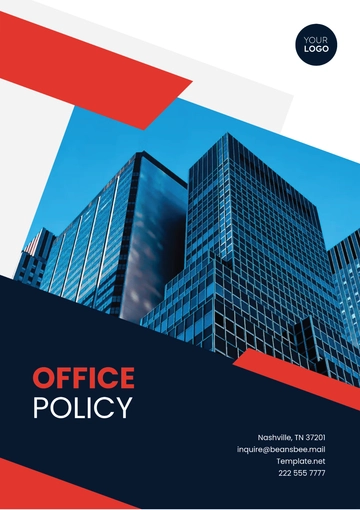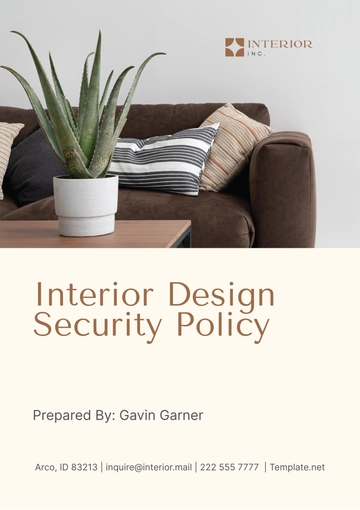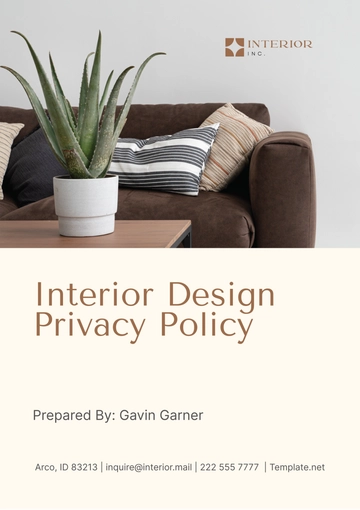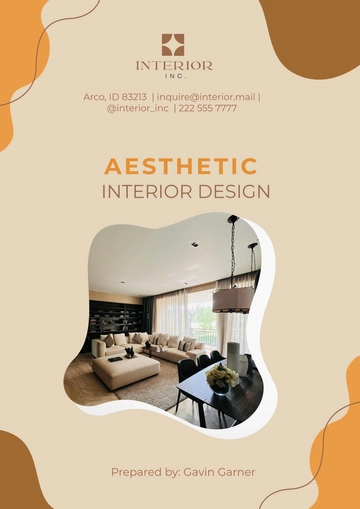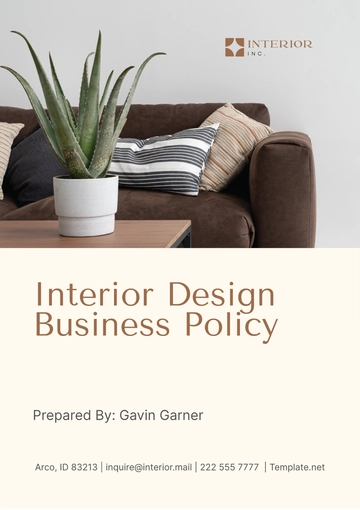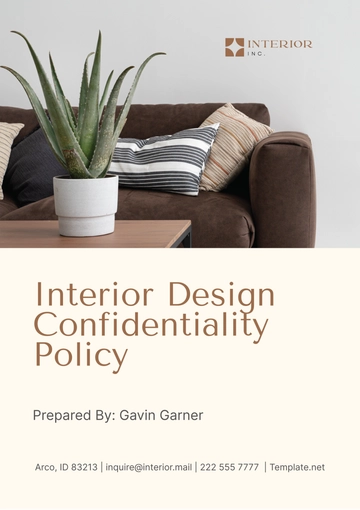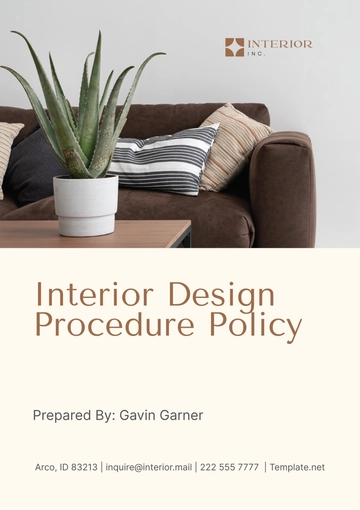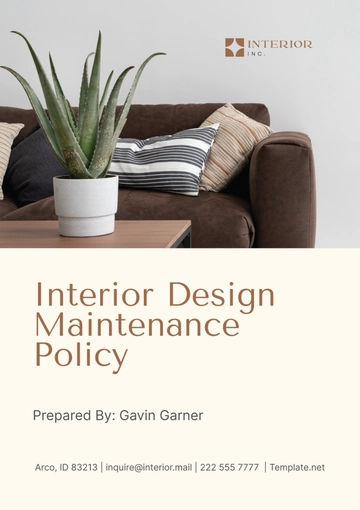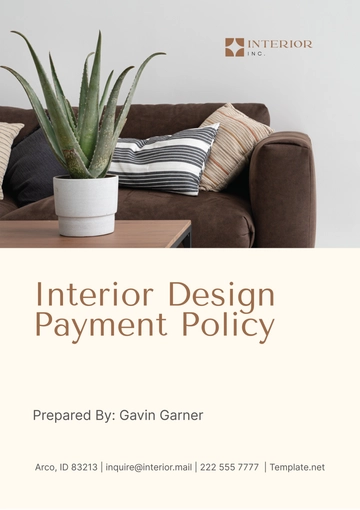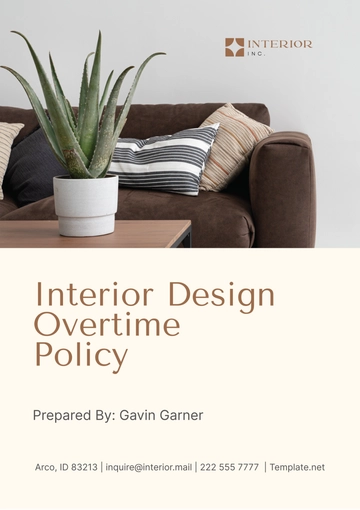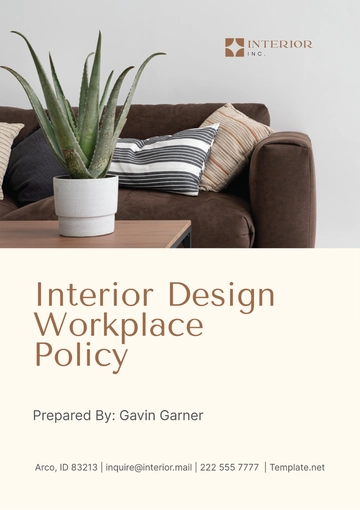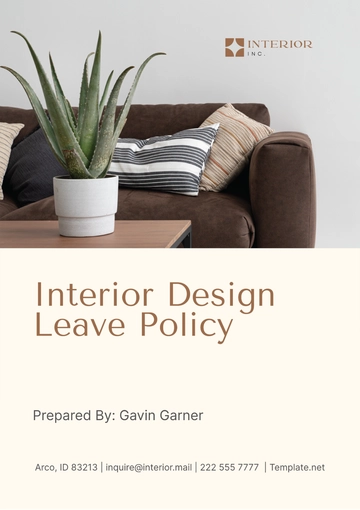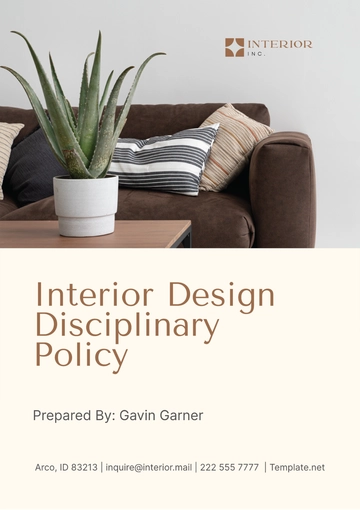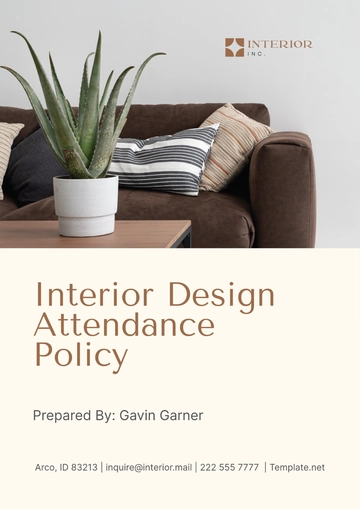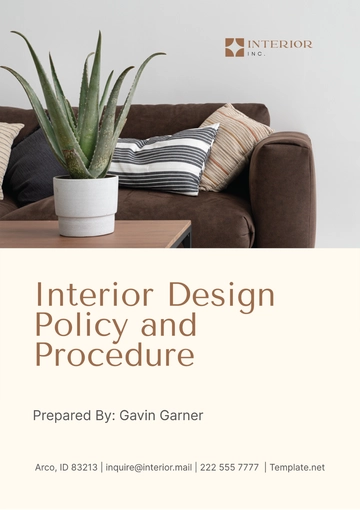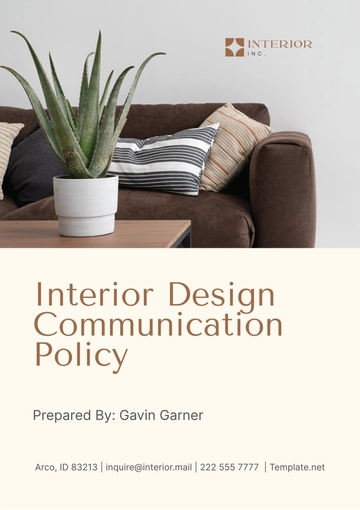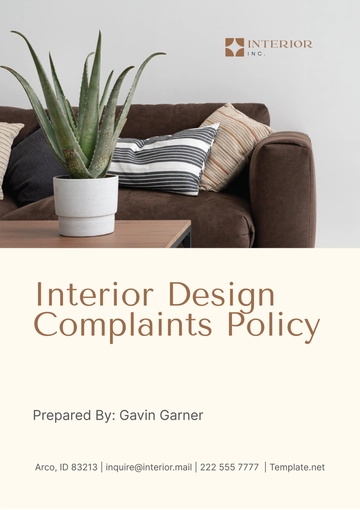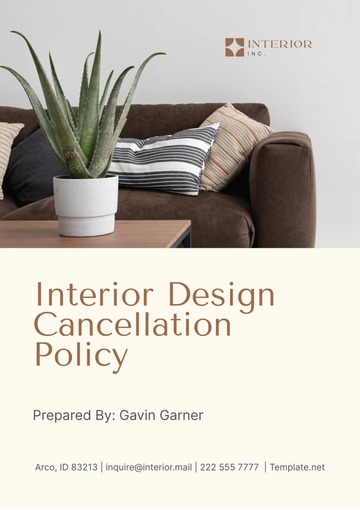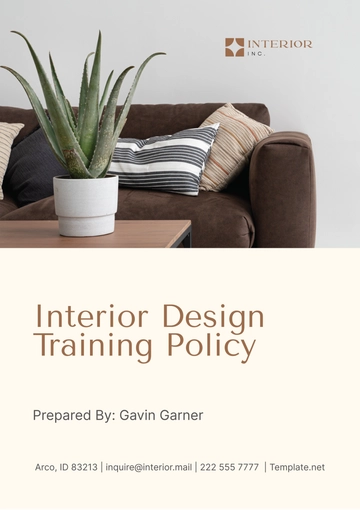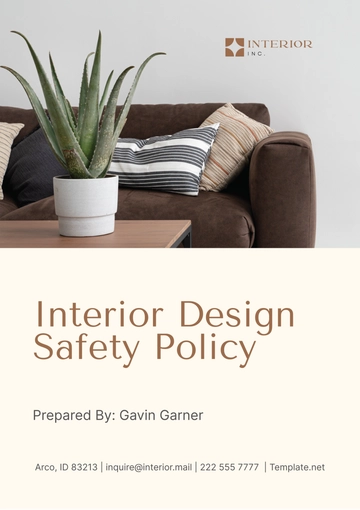Free Interior Design Maintenance Policy

I. Policy Overview
This Interior Design Maintenance Policy of [Your Company Name] is a comprehensive framework that outlines the procedures, responsibilities, and standards for maintaining the aesthetic integrity and functionality of our interior design elements. This policy is integral to ensuring that our physical environment continues to reflect our brand, support our operational efficiency, and provide a comfortable and inspiring space for our employees and visitors.
A. Scope
The scope of this policy extends to all interior design elements within our company-owned properties. These elements include, but are not limited to:
Furniture: Regular maintenance and repair of furniture items are crucial to preserving their functionality and aesthetic appeal. This includes tasks such as cleaning, polishing, and repairing any damage. By doing so, we ensure that our furniture continues to serve its purpose while contributing to the overall aesthetic of our spaces. It also extends the lifespan of our furniture, providing cost savings in the long run.
Wall Decorations: Wall decorations such as paintings, murals, and wall hangings need to be regularly cleaned and checked for any signs of damage or wear and tear. This helps to maintain their visual appeal and preserve the artistic value they add to our spaces. Regular maintenance also prevents any potential damage from worsening, thereby avoiding costly replacements.
Lighting Fixtures: Lighting fixtures not only illuminate our spaces but also contribute to the overall design aesthetic. Regular maintenance ensures they function effectively and continue to enhance our interior spaces. This includes tasks such as replacing burnt-out bulbs and ensuring the fixtures are clean and free from dust.
Carpets: Carpets require regular cleaning to maintain their appearance and longevity. This includes vacuuming, stain removal, and professional deep cleaning as needed. Regular maintenance helps to preserve the quality and texture of our carpets, enhancing the comfort and aesthetic appeal of our spaces.
Color Schemes: The color schemes of our interior spaces play a significant role in creating the desired ambiance. Regular maintenance ensures that the colors remain vibrant and true to the original design. This includes tasks such as repainting walls and refinishing furniture to maintain the consistency of our color schemes.
B. Objectives
The objectives of this policy are to:
Maintain Optimal Condition: Ensure that all interior design elements are kept in their best condition, enhancing the overall aesthetic appeal of our premises. Regular maintenance helps to prevent wear and tear, keeping our spaces looking fresh and inviting.
Align with Corporate Identity: Ensure that all design elements align with our corporate identity, reinforcing our brand image. Regular maintenance ensures that our spaces continue to reflect our brand values and aesthetics.
Implement Regular Inspections and Maintenance: Implement regular inspections and maintenance schedules, ensuring timely detection and rectification of any issues. This helps to prevent minor issues from escalating into major problems, thereby saving time and resources.
Provide Comfortable and Inspiring Spaces: Provide a comfortable, safe, and inspiring space for our employees and visitors, enhancing their experience within our premises. Regular maintenance contributes to a positive and inspiring environment, boosting productivity and satisfaction among our employees and visitors.
Promote Sustainability: Promote sustainability in our maintenance practices, contributing to environmental conservation and social responsibility. Regular maintenance helps to extend the lifespan of our interior design elements, reducing waste and promoting sustainability.
II. Maintenance Guidelines
A. Regular Inspection
Regular inspections are a crucial part of our maintenance policy. These inspections are conducted to assess the condition of all interior design elements. The following table outlines the inspection schedule:
Area | Inspection Frequency | Responsible Party |
|---|---|---|
Main Lobby | Quarterly | Facilities Management |
Conference Rooms | Quarterly | Facilities Management |
Employee Work Areas | Bi-annually | Office Managers |
Break Rooms | Annually | Facilities Management |
The Main Lobby is the first point of contact for visitors and employees, and it plays a significant role in creating a positive first impression. Therefore, it is inspected quarterly by the Facilities Management team to ensure it remains welcoming and reflects our brand image.
Conference Rooms are also vital spaces where important meetings and discussions take place. Regular quarterly inspections by the Facilities Management team ensure these spaces remain functional and conducive for effective communication.
Furthermore, Employee Work Areas are the spaces where our employees spend most of their time. Bi-annual inspections by Office Managers ensure these spaces remain comfortable, safe, and conducive to productivity.
Lastly, Break Rooms are spaces where employees can relax and rejuvenate. Annual inspections by the Facilities Management team ensure these spaces continue to provide a comfortable and relaxing environment for our employees.
Regular inspections are crucial in maintaining the aesthetic appeal and functionality of our interior design elements. They allow us to identify and rectify any issues promptly, preventing minor issues from escalating into major problems. This proactive approach not only helps to maintain the quality of our interior spaces but also contributes to a positive and inspiring environment.
Furthermore, regular inspections demonstrate our commitment to excellence and attention to detail. They reflect our dedication to providing a comfortable, safe, and inspiring space for our employees and visitors. By ensuring our interior spaces are well-maintained, we enhance the overall experience of anyone who visits or works in our premises. This not only boosts productivity among our employees but also reinforces our brand image among our visitors.
B. Maintenance Work
Maintenance work is a critical component of our Interior Design Maintenance Policy. It involves a range of activities aimed at preserving the aesthetic appeal and functionality of our interior design elements. All maintenance work must be carried out by qualified personnel to ensure the highest standards of workmanship and safety. Here are some key aspects of our maintenance work:
Urgent Maintenance: Urgent issues that affect operational efficiency or safety are to be addressed immediately. This includes issues such as broken furniture, malfunctioning lighting fixtures, or damaged wall decorations. Addressing these issues promptly helps to prevent accidents, maintain productivity, and ensure the comfort and safety of our employees and visitors.
Non-Urgent Maintenance: Non-urgent maintenance refers to routine tasks that do not require immediate attention. This includes activities such as cleaning, polishing, and minor repairs. These tasks are scheduled in a way that minimizes disruption to our operations and ensures the longevity and aesthetic appeal of our interior design elements.
Specialized Maintenance: Certain elements of our interior design may require specialized maintenance. This includes items such as antique furniture, specialty lighting fixtures, or unique wall decorations. These items are maintained by personnel with the necessary skills and expertise to ensure their proper care and preservation.
Preventive Maintenance: Preventive maintenance involves regular inspections and maintenance activities designed to prevent potential issues before they occur. This proactive approach helps to extend the lifespan of our interior design elements, reduce maintenance costs, and maintain the aesthetic appeal of our spaces.
Corrective Maintenance: Corrective maintenance involves the repair or replacement of interior design elements that have become damaged or worn out. This ensures that our spaces continue to reflect our brand image and provide a comfortable and inspiring environment for our employees and visitors.
C. Design Alignment
Design alignment is a key aspect of our maintenance policy. Any replacement or alteration of interior elements must align with the original design themes approved by the Corporate Brand Committee. This includes maintaining color schemes, material quality, and design motifs. Here are some key aspects of our design alignment:
Color Scheme Consistency: Maintaining the consistency of our color schemes is crucial in preserving the visual appeal and mood of our spaces. This involves ensuring that any new or replacement items match the existing color scheme, and that any necessary repainting or refinishing is done in the correct colors.
Material Quality: The quality of materials used in our interior design plays a significant role in the overall aesthetic and durability of our spaces. Therefore, any replacement items must be of the same or higher quality as the original items. This ensures that our spaces continue to reflect our commitment to quality and excellence.
Design Motif Continuity: Our design motifs add a unique touch to our spaces and contribute to our brand identity. Therefore, any alterations or additions to our interior design must be in line with these motifs. This ensures a cohesive and harmonious look and feel across all our spaces.
Brand Identity Preservation: Our interior design is a reflection of our brand identity. Therefore, all maintenance work must preserve this identity. This involves ensuring that all elements of our interior design, from the color schemes to the design motifs, align with our brand image and values.
Stakeholder Consultation: Any significant changes to our interior design must be approved by the Corporate Brand Committee. This ensures that all stakeholders have a say in the design process and that any changes align with our corporate identity and strategic objectives.
III. Roles and Responsibilities
The successful implementation of our Interior Design Maintenance Policy requires the active participation of various parties within [Your Company Name]. Each party has a specific role to play and responsibilities to fulfill to ensure the aesthetic integrity and functionality of our interior design elements.
A. Facilities Management
Facilities Management plays a crucial role in the implementation of our maintenance policy. Their responsibilities include:
Implementing Maintenance Schedules: Facilities Management is responsible for developing and implementing the maintenance schedules. This involves planning the timing and frequency of maintenance activities to ensure minimal disruption to our operations. It also involves coordinating with other parties to ensure the smooth execution of these activities.
Overseeing Repairs: Any repair work that needs to be done as part of the maintenance process falls under the purview of Facilities Management. They are responsible for ensuring that the repair work is carried out correctly and efficiently, maintaining the high standards of our interior design.
Ensuring Quality Standards: Facilities Management is also responsible for ensuring that all maintenance work meets our quality standards. This involves checking the work done by maintenance personnel and ensuring that it aligns with our design guidelines and quality expectations.
B. Office Managers
Office Managers have a key role in maintaining the interior design elements within their respective areas. Their responsibilities include:
Reporting Damages: Office Managers are responsible for reporting any damages or issues they notice in their respective areas. This allows us to address these issues promptly and prevent them from escalating.
Coordinating Maintenance Activities: They also play a role in coordinating maintenance activities within their areas. This involves working with Facilities Management to schedule these activities and ensure they are carried out smoothly.
Ensuring Compliance: Lastly, they are responsible for ensuring that all employees within their areas comply with the maintenance policy. This includes educating employees about the policy and monitoring their adherence to it.
C. Corporate Brand Committee
The Corporate Brand Committee plays a crucial role in ensuring that our maintenance activities align with our corporate identity. Their responsibilities include:
Approving Design Alterations: Any alterations to our interior design must be approved by the Corporate Brand Committee. They ensure that these alterations align with our corporate identity and design guidelines.
Maintaining Design Consistency: The Corporate Brand Committee is also responsible for maintaining consistency in our interior design across all our properties. This involves regularly reviewing our spaces and ensuring they reflect our brand image.
Guiding Design Decisions: The committee provides guidance on design decisions related to maintenance activities. This ensures that these decisions align with our design philosophy and enhance the aesthetic appeal of our spaces.
IV. Compliance and Reporting
The Interior Design Maintenance Policy of [Your Company Name] is a crucial framework that ensures the aesthetic and functional integrity of our workspaces. Adherence to this policy is not just a requirement but a commitment to excellence and professionalism. Here is an overview of the steps involved in the compliance and reporting process:
No. | Step | Description |
|---|---|---|
1 | Compliance | All employees are required to comply with the established procedures. |
2 | Reporting | Any deviations or issues encountered should be reported. |
3 | Resolution | Facilities Management will address the reported issues. |
A. Compliance
Compliance is the first step in maintaining the integrity of our interior design. It involves the following:
Understanding the Policy: Each employee should have a thorough understanding of the policy. This includes the standards set for the design and the procedures for maintenance. This understanding forms the foundation for effective compliance.
Adherence to Procedures: The procedures outlined in the policy should be followed meticulously. This ensures the longevity and quality of the design. Consistent adherence to these procedures is key to maintaining the aesthetic appeal of our workspaces.
Regular Checks: Employees should regularly check their respective areas for any deviations from the policy. These checks help in early detection of any potential issues, thereby preventing them from escalating.
Immediate Correction: Any minor deviations noticed should be corrected immediately to prevent further issues. Immediate correction helps in maintaining the design integrity and reduces the need for major corrective actions later.
B. Reporting
Reporting is a crucial part of this policy. It involves:
Identifying Issues: Employees should be vigilant in identifying any issues or deviations from the policy. This vigilance ensures that no issue goes unnoticed and can be addressed promptly.
Documenting the Issue: The identified issue should be documented with all relevant details. Proper documentation provides a clear understanding of the issue, which is crucial for its resolution.
Reporting to Facilities Management: The documented issue should be reported to Facilities Management promptly. Timely reporting enables quick action from the Facilities Management team.
Awaiting Resolution: After reporting, employees should await the resolution of the issue by Facilities Management. This patience allows the Facilities Management team to effectively address the issue.
C. Resolution
Resolution is the final step in this process. It involves:
Receiving the Report: Facilities Management will receive the report from the employees. This reception marks the beginning of the resolution process.
Assessing the Issue: The reported issue will be assessed for its severity and impact. This assessment helps in understanding the extent of the problem and planning the resolution accordingly.
Planning the Resolution: A plan will be made to resolve the issue in the most efficient way. This plan is designed keeping in mind the nature of the issue and the best possible solution.
Implementing the Resolution: The resolution plan will be implemented to rectify the issue. This implementation is carried out meticulously to ensure effective resolution.
Confirming the Resolution: After implementation, it will be confirmed if the issue has been resolved satisfactorily. This confirmation ensures that the issue has been fully addressed and there are no residual problems.
The importance of this policy cannot be overstated. It ensures that our workspaces remain aesthetically pleasing and functionally efficient. By adhering to the policy, we maintain a professional environment that is conducive to productivity and creativity.
Moreover, the reporting process allows for the timely resolution of any issues that may arise. This proactive approach prevents minor issues from escalating into major problems. It also ensures that our interior design remains in line with the established standards.
Finally, the resolution process ensures that any reported issues are addressed promptly and effectively. This not only maintains the quality of our interior design but also demonstrates our commitment to excellence and professionalism. By adhering to this policy, we uphold the values of [Your Company Name] and contribute to its success.
V. Policy Review and Updates
The Interior Design Maintenance Policy of [Your Company Name] is a living document that evolves with the changing needs and standards of our organization. It is important to regularly review and update this policy to ensure its relevance and effectiveness.
A. Policy Review
The review of the policy is a critical process that ensures its continued relevance and effectiveness. It involves the following steps:
Review Initiation: The review process begins with the identification of the need for a review. This could be due to changes in design trends, organizational needs, or feedback from employees.
Policy Evaluation: The current policy is thoroughly evaluated to identify its strengths and weaknesses. This evaluation provides valuable insights into the areas that need improvement.
Feedback Collection: Feedback is collected from various stakeholders, including employees, management, and external design consultants. This feedback provides diverse perspectives on the policy’s effectiveness.
Review Analysis: The feedback and evaluation results are analyzed to identify key areas for improvement. This analysis forms the basis for the policy updates.
Review Conclusion: The review process concludes with a comprehensive report detailing the findings and recommendations for policy updates.
B. Updates
Updates to the policy ensure that it remains effective and relevant. The update process involves the following steps:
Update Planning: Based on the review findings, a plan for updating the policy is developed. This plan outlines the changes to be made and the timeline for implementing these changes.
Policy Revision: The policy is revised according to the update plan. This revision incorporates the recommended changes and improvements.
Stakeholder Review: The revised policy is shared with stakeholders for review. Their feedback is considered before finalizing the updates.
Policy Finalization: After incorporating the feedback, the updated policy is finalized. This final version represents the current standards and procedures for interior design maintenance at [Your Company Name].
The regular review and update of the Interior Design Maintenance Policy is crucial for maintaining the aesthetic and functional quality of our workspaces. By ensuring that the policy reflects current design trends and organizational needs, we can create an environment that fosters creativity, productivity, and well-being. This commitment to continuous improvement is a testament to [Your Company Name]'s dedication to excellence and professionalism in all aspects of our operations.
- 100% Customizable, free editor
- Access 1 Million+ Templates, photo’s & graphics
- Download or share as a template
- Click and replace photos, graphics, text, backgrounds
- Resize, crop, AI write & more
- Access advanced editor
Implement effective maintenance policies effortlessly with the Interior Design Maintenance Policy Template only on Template.net! This practical resource offers an editable solution for defining maintenance procedures. Utilize the customizable features to tailor the policy to suit your needs. Generate with ease with the help of our advanced AI Editor Tool!
You may also like
- HR Policy
- Restaurant Policy
- Company Policy
- Accounting Policies and Procedures
- Website Policy
- Privacy Policy
- Safety Policy
- School Policy
- IT and Software Policy
- Law Firm Policy
- Construction Policy
- Interior Design Policy
- Travel Agency Policy
- Education Academic Policy
- Security Policy
- Real Estate Policy
- Expense Policy
- Software Policy
